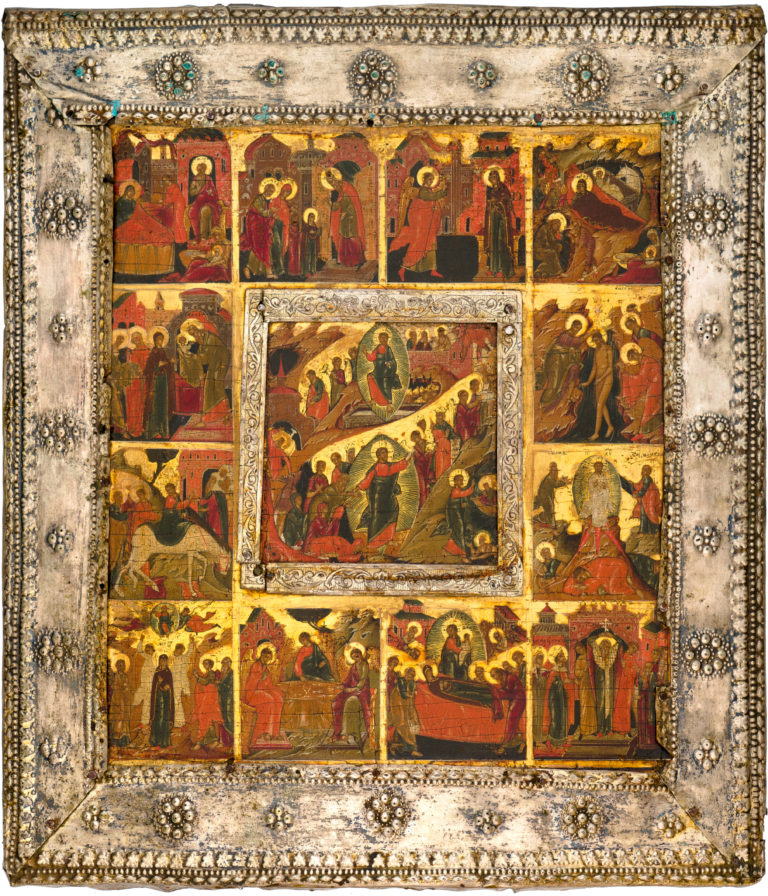The Resurrection—the Descent into Hell, with Church Feasts in 12 Border Scenes
Antique Russian icon: middle – second half of the 19th century. Mstyora (?).
Oklad cover: end of the 17th century.
Size: 31 х 27 х 3 cm
Wood (one whole panel), two incut smooth support board (the top one is now lost), the shallow incut centerpiece, underlying layer of gesso is not visible, gesso, tempera. Oklad cover: white metal, embossment, silver plating, engraving.
The author’s paintwork is chafed in places and covered with a crazing net; small fallouts of gesso across the entire surface. Small restoration tonings. The oklad cover is in a good state. Part of the surface has darkened. Small losses of metal of the side panels, coming up to the border scenes.
Contact us

The Resurrection—the Descent into Hell, with Church Feasts in 12 Border Scenes
Diagram of the border scenes:
- The Nativity of the Mother of God;
- The Entrance of the Mother of God into the Temple;
- The Annunciation;
- The Nativity of Christ;
- Candlemas (The Meeting of Christ in the Temple);
- The Theophany (The Baptism of Christ);
- The Entrance into Jerusalem;
- The Transfiguration;
- The Ascension;
- The Old Testament Trinity;
- The Dormition of the Mother of God;
- The Elevation of the Holy Cross.
The centerpiece of the given antique Russian icon bears the depiction of the Resurrection – The Harrowing of Hades, which includes both, the historical religious icon image – the Rising from the Tomb and the symbolic – the Harrowing of Hades. The number of scenes is brought to a minimum: in the lower right corner, we see only one Gospel narrative – the Revelation of Christ to the Apostles on the Sea of Galilee (John 21: 1-25). The surrounding border scenes are placed in chronological order, in a highly traditional manner.
The material and artistic traits of this hand-painted icon unravel the artist’s desire to add a touch of antiquity to the work. The master iconographer chooses an old, rough wood panel for the icon and skillfully adds artificial hazing that covers the entire surface in an ‘all too smooth’ fashion. The artist’s orientation on Russian icon art of the first half of the 17th century clearly comes through in the traditionalist iconography and the religious icon’s artistic traits: the subtle color scheme, the rather free composition of the border scenes, the miniature-painting style, the character of the architectural staffage, the small lights of the mountainsides.
In the second half of the 19th century, the increasing interest in Medieval art drove iconographers to a new form of trade – creating forged medieval hand-painted icons for the just-born antique market. Mstyora artists were especially prominent in this field. They not only knew Old Russian icon art with its schools and variations but also laid the foundation of the modern-day religious icon restoration techniques. Thus, they brilliantly imitated the technique, style, and iconography, as well as skillfully “aged” hand-painted icons. Using centuries-old boards and dark pigments, they imitated the darkened varnish, aged the paintwork, imitated hazing with graphic work, and forged the “author’s” autographs and inscriptions. Numerous green and brown tones in the color pallet also “give away” the recognizable style of Mstyora’s religious icon painters.
The oklad cover was selected for this antique Russian icon after it was complete, which also indicates the religious icon painter’s desire to “age” the piece. It consists of four plates (brought together at a slight angle, with one plate coming on to another), which is typical for Medieval-period pieces (in the Imperial era they were replaced by whole-piece oklads). The oklad frame finds numerous analogies among the 17th-century covers but lacks the tall towers and is decorated with quite a simple type of ornamentation – thin strands of “pearls,” “stones” (diamond-like crystal shapes), and small stars, which indeed imitates the more precious oklads. The small surface is, in turn, decorated with sparsely placed rosettes. The Harrowing of Hades scene is separated from the border scenes by the frame with an engraved ornament.